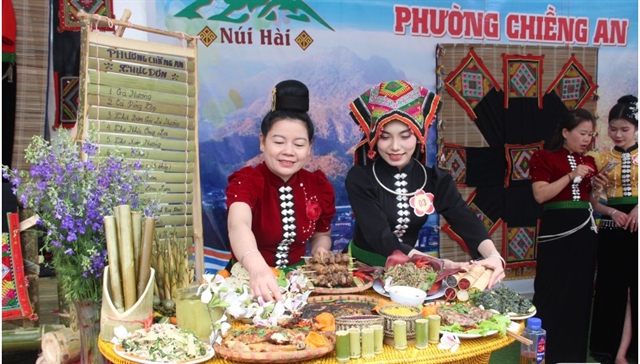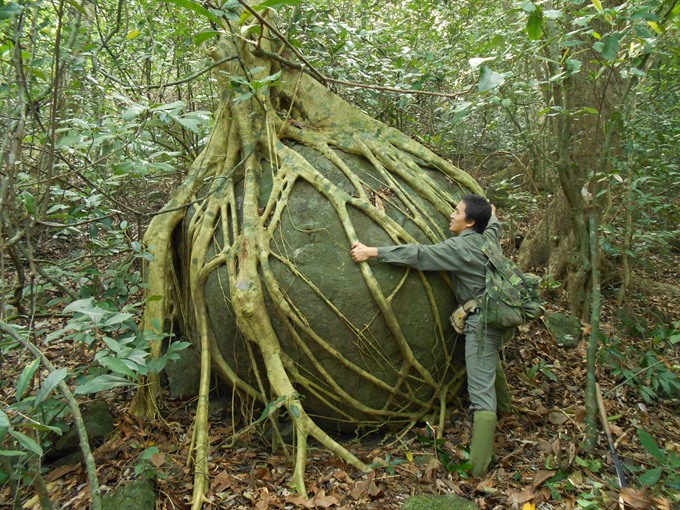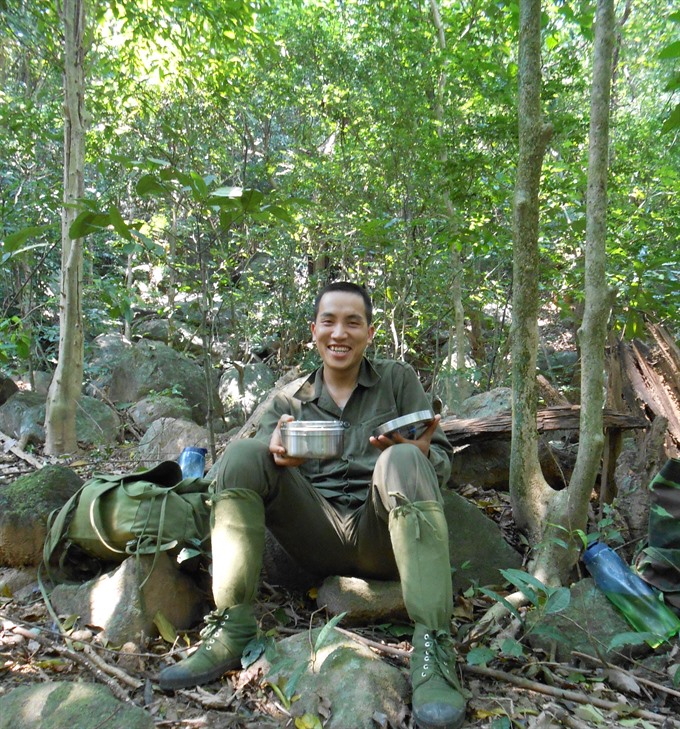 Features
Features

Having graduated with a degree in biology and environmental studies from the Đà Nẵng Teachers’ Training College, Bùi Văn Tuấn has explored remote forests across central Việt Nam to conduct his scientific research on primate species and their diets, as well as the rich forest biodiversity of the region.
 |
| Tent time: Bùi Văn Tuấn prepares accommodations on a jungle trip in Sơn Trà nature reserve in Đà Nẵng City. — VNS Photo Bùi Văn Tuấn |
Having graduated with a degree in biology and environmental studies from the Đà Nẵng Teachers’ Training College, Bùi Văn Tuấn has explored remote forests across central Việt Nam to conduct his scientific research on primate species and their diets, as well as the rich forest biodiversity of the region.
The 4,439ha Sơn Trà Nature Reserve in Đà Nẵng has been his favourite site since he began studying Vietnamese biodiversity and the endangered red-shanked douc langurs (Pygathrix nemaeus) population living in the reserve.
Tuấn, 33, and a research team from the Biodiversity Conservation Centre of GreenViet, an NGO in Đà Nẵng, are conducting a 10-year study of every corner of the reserve to research the endangered langurs. Their latest report, released in 2017, revealed that the reserve is home to more than 237 flocks of the langurs, over 1,300 individuals.
 |
| Tree hugger: The wild nature of Sơn Trà forest. — VNS Photo Bùi Văn Tuấn |
“It’s an amazing result for us. My colleagues and I spent one year following the movement of the langur flocks on 16 routes into the jungle, over a total accumulated length of 136km,” Tuấn recalled.
“The research forced me to come to Sơn Trà every day, whether it was raining or hot. The langurs often move around jungle to eat young leaves from different trees. That’s why we couldn’t stop heading into nature to keep watching them,” he said.
He added that the time he spent watching and searching for the langurs during this period was longer than the time he spent with his family.
“I did not miss a single day observing them as then I would lose a chance to upload notes for my scientific report on the existence of the endangered primates.”
The biologist said it was a tough road. He had to follow every mile on which herds of langurs traveled through the jungles.
As the langurs often seek food during a four-hour period in the morning, biologists have to sit in camouflage for hours and watch them eat through binoculars.
“We must act like them (langurs) when approaching them. It’s because the biggest langur of a herd will warn the other langurs of the appearance of strangers. So, I had to wear green with the same jungle colour, and could not change my clothes over the next few days,” he explained.
Tuấn said the langurs feel fear when strangers approach too close to them as they can smell them from the air.
He explained that in order to approach the langurs, people must wear the same clothes for several days so that the langurs grow accustomed to the scent and will not flee.
 |
| Hey buddy: One of the endangered red-shanked douc langurs (Pygathrix nemaeus)seen by Bùi Văn Tuấn in the Sơn Trà Nature Reserve. — Photo courtesy Bùi Văn Tuấn |
Langurs’ habitat
After becoming familiar with the langurs, Tuấn has developed a friendship with them and can observe them at quite a close range.
He can locate the movement of langurs in the jungle by searching for trees belonging to the species of which the langurs often eat young leaves – their major daily food. There are some 200 plant species they frequently eat.
As a rule, langurs move in a circle in the jungle to find young leaves. Eventually, a flock returns to the first tree on which they dined and will start the next circle.
Tuấn was impressed with one langur flock leader that had a scar on its face, so he named it The Scarred One.
He said The Scarred One was waging a war against another flock of langurs for control of the food chain in the jungle. In a flock, the strongest male langur becomes the leader to protect the others and takes charge of seeking safe zones for eating.
Tuấn said the langurs are human-like in the way they protect their families.
“The flock leader always check and mark the trees that can feed the herd with their young leaves. It tests first before other individuals in the flock eat at marked trees,” he explained.
“The leader always sits on the top of tree – the highest position – to cover the flock. He will be the last in the flock to eat the last young leaves on trees. The leader also gives punishment to young langurs if they do not obey his orders,” Tuấn said.
He said the leader will only be replaced when it becomes older, and when the flock grows and splits off into new flocks.
 |
| Yum: Lunch in the jungle. — VNS Photo Bùi Văn Tuấn |
In jungle
Tuấn and his colleagues from GreenViet faced many dangers as they sat in the jungle of Sơn Trà, watching the langurs.
Malaria, dog fleas and American dog ticks and vipers were the greatest dangers for biologists on their long trips tracking langurs in jungle.
“We have been sent to hospital after long trips in jungle, but just for quick scares that were easily treated at the hospital. Love of nature and the primates conquers all. We in turn track langurs in the jungle every month to collect data and evidence of new flora and fauna species. It helps us know more about the unique rich biodiversity of the Sơn Trà Reserve and the importance of nature to human beings.”
Tuấn said the dog flea bite could cause itching for months or require a year dermatology treatment.
He said he was bitten by 40 dog fleas on one jungle trip few years ago, but he had experience with the cure and quickly healed himself.
“I used a lighter to burn the bug to shrink its stinger out of skin. If you remove it, it leaves its stinger inside the skin and keeps poisoning the skin. A member of our research team had spent one year treatment in HCM City for one bite of the dog flea in the Sơn Trà Reserve.”
Tuấn said he hoped his scientific reports on the latest population figures of the endangered langurs living in the Sơn Trà Reserve would be soon posted in Science Magazine, a peer-reviewed academic journal of the American Association for the Advancement of Science.
Tuấn and his partners have also continued to research and work to conserve the critically endangered gray-shanked douc langurs (Pygathrix cinerea) in Kon Ka Kinh National Park in Gia Lai and Quảng Nam province and the endangered Hatinh langurs, in Hà Tĩnh Province.
The biologists from GreenViet have been working on the Sơn Trà Reserve to seek out scientific information on the existence of wildlife and guide nature conservation efforts.
Their scientific reports can help stop the invasion of buildings, resorts and hotel projects as well as illegal hunting and logging in the reserve – which is home to 370 animal species and 1,010 plant species.
Tuấn has been co-operating with the Frankfurt Zoological Society of Germany, the San Diego Zoo Global in the United States and the IUCN to raise awareness of the need to protect the red-shanked douc langurs through long-term campaigns in the reserves of Sơn Trà and Bà Nà-Núi Chúa in Đà Nẵng city. — VNS




